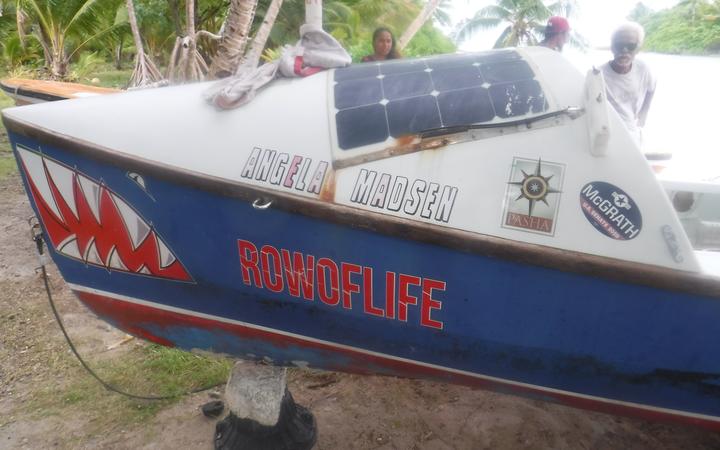Boat of US paralympian Angela Madsen found in Marshall Islands
Wednesday 10 November 2021 | Written by RNZ | Published in Marshall Islands, Regional

Mili Islanders look at American paralympic paddler Angela Madsen's boat, which washed up on Mili Atoll in late October - 16 months after Madsen's body was was found mid-way between California and Hawaii on her ill-fated attempt to paddle solo last year. Photo: Benjamin Chutaro
The boat used by American paralympian Angela Madsen on her ill-fated attempt in mid-2020 to paddle solo from California to Hawaii has washed up on a remote atoll in the Marshall Islands.
The specially designed boat with her name and "ROWOFLIFE" painted on the hull, washed up on Mili Atoll in late October, 16 months after her body was found mid-way between California and Hawaii by the US Coast Guard.
Madsen was a noted paddler, having twice paddled across the Atlantic Ocean, crossed the Indian Ocean, and earlier paddled across the Pacific Ocean with a partner. Although she was a paraplegic due to surgery following a back injury she sustained in the US military in her early 20s, she turned to paddling later in life and won four gold medals and a silver medal while rowing with the US paralympic team at different world championships. She also competed at the Beijing, London and Rio paralympics in rowing, shot put and javelin.
The US Coast Guard reported finding the body of Madsen, 60, on June 22, 2020 over 1,100 miles west of California, close to the halfway point of her paddle to Hawaii. The Coast Guard responded the day after communication from Madsen stopped a few hours after she indicated she was going into the water to make a repair on the boat. The Coast Guard found her body in the water, tethered to the approximately 15-foot boat.
The boat was not rescued at the time Madsen's body was pulled from the water. It has been drifting for 16 months until washing up on Mili Atoll late last month.
Mili Islander Benjamin Chutaro, who lives in the capital atoll of Majuro, visited Mili by boat in late October and while there, learned that islanders had discovered the boat on an east-facing shoreline.
On Chutaro's return to Majuro Monday night, he provided photographs of Madsen's boat and some details about the vessel.
"Unfortunately, a lot of the equipment was ransacked by (people) from Lukonor Island," Chutaro said. "I did find the EPIRB with her NOAA (US National Oceanic and Atmospheric Administration) identification number." An EPIRB is an emergency position indicating radio beacon.
The boat was outfitted with numerous cameras as part of an effort to make a movie of the single-handed voyage across the Pacific.
Chutaro said he saw "about four to five" mounts for GoPro cameras on the vessel, but no cameras. "I found out that people took the GoPros and were watching them," he said. "I was not able to locate any of them. Hopefully none of the footage was erased."
Chutaro added: "I found a lot of high quality gear onboard and gear that were taken off."
Contacted Monday evening, US Ambassador to the Marshall Islands Roxanne Cabral and Marshall Islands Police Department Deputy Commissioner Eric Jorbon said they had not been informed of the discovery of the boat, but would look into it.
With ocean currents from the eastern Pacific heading in a westerly direction, the Marshall Islands has encountered numerous drifters, boats of people lost at sea, and professionally wrapped packages of cocaine over the past 40 years. These have washed into many different parts of the Marshall Islands, a watery expanse of low-lying coral atolls that cover 700,000 square miles of ocean area in two chains of islands in the central Pacific just north of the equator.
In 1988, 10 years after a group of five fishermen was lost at sea off Maui, Hawaii, their small boat the Sarah Joe was discovered washed up on uninhabited Taongi Atoll in the northern part of the country.
In 2006, a group of three Mexicans was rescued close to the Marshall Islands by a Marshall Islands-flagged fishing vessel after drifting for 295 days.
In 2014, Salvadoran Jose Alvarenga grabbed international headlines after drifting for a year from Mexico to Ebon Atoll in the southern Marshall Islands.
He later wrote a book, "348 days," about his voyage. Last December, residents of northern Ailuk Atoll discovered an 18-foot outboard engine boat that was loaded with over 1,400 pounds of professionally wrapped cocaine, which was confiscated and incinerated by police.














































